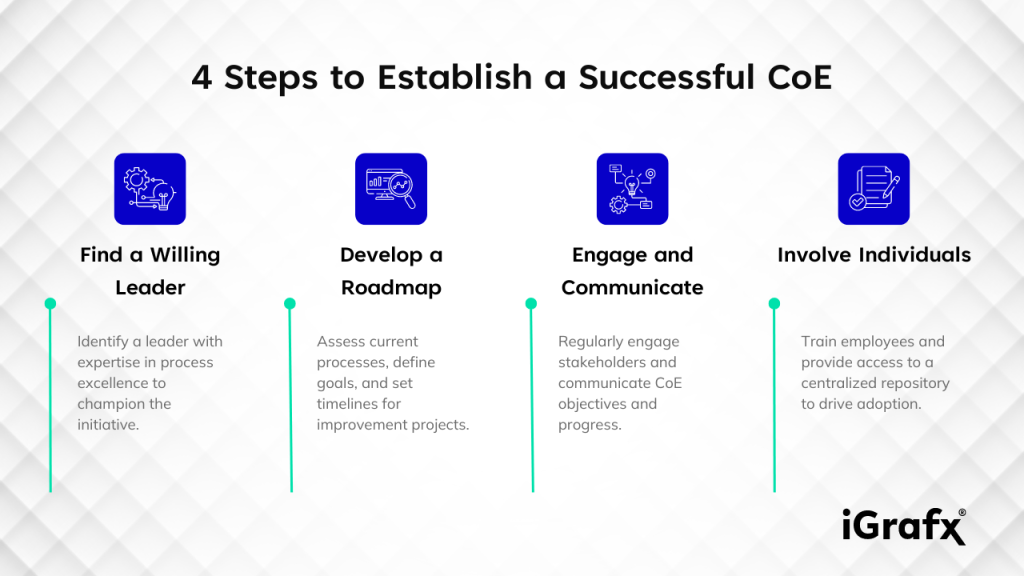Process excellence is the cornerstone of a thriving business. Yet, many organizations struggle to maintain a consistent focus on improvement.
A Center of Excellence (CoE) provides the structure and resources needed to drive continuous optimization, ensuring that operations remain efficient and effective.
Discover how to develop a Process Center of Excellence in our comprehensive guide.
What is a Process Center of Excellence?
A Process Center of Excellence (COE) is a specialized department or team within an organization that’s dedicated to enhancing business processes.
The CoE identifies areas for improvement, standardizes processes, ensures compliance, and trains employees. A CoE will help your organization reduce costs and increase its performance when developed and executed correctly.
Every company, regardless of its size, has processes that are key to daily operations, employee performance, and customer satisfaction.
In the past, businesses often saw building process maps as a one-off task, but achieving true process excellence requires establishing a culture of continuous monitoring and improvement.
How does a Process Center of Excellence work?
Imagine trying to align an organization’s culture with process excellence techniques. Large businesses with multiple departments will struggle to get buy-in and ensure compliance from all stakeholders. That’s where a Process Center of Excellence plays a key role.
These centers are hubs for best practices, information, and expertise. They also enable organizations to implement a process management framework, empowering each manager and employee to contribute to long-term goals.
Whether you have a small business or an international organization, building a successful Center of Excellence requires a strategic approach.
The benefits of a Process Center of Excellence
Process excellence might require time and financial investment, but its long-term applications benefit organizations of all sizes. Centralizing process management resources and expertise can help your business plan for the future.
Let’s take a look at the many benefits of developing a CoE.
Enhance productivity and efficiency
A Process Center of Excellence (CoE) establishes a structured approach to process management that focuses on standardization and continuous improvement.
By standardizing practices across an organization, a CoE ensures that all teams follow the most effective and efficient methods for completing tasks, reducing variability and minimizing inefficiencies.
Redundancy is eliminated, workflows are executed consistently, and employees adhere to best practices. This leads to more predictable outcomes, faster execution, and better overall performance.
As the National Institute of Standards and Technology (NIST) reported, effective business process management often increases productivity by 50%.
Customer satisfaction
Customer satisfaction is everything. You’ve heard it all before, so we won’t say it again. When you can offer speedy, quality service to your customers, they’ll come back for more. Process improvement is intrinsic to aligning with customer demands and building a successful business.
A Process Center of Excellence ensures that business processes are optimized, consistent and aligned with customer needs.
By standardizing and continuously improving processes, the CoE enables faster, more reliable delivery of products and services, reducing errors and increasing quality.
Customers benefit from improved service levels, shorter response times, and more accurate solutions, all of which enhance the overall customer experience.
According to BPM Trends, over 70% of European businesses say business process management enhances customer satisfaction.
Facilitating innovation
Innovation is the key that unlocks ongoing business growth. Without it, your company would remain stagnant and fail to adapt.
A CoE provides the ideal environment for experimenting with new ideas, technologies and methodologies within business processes.
By promoting best practices and continuous improvement, the CoE encourages teams to explore creative solutions to remove process inefficiencies and bottlenecks.
It also integrates emerging technologies, like automation and AI, into process optimization. With a culture of innovation, organizations can adapt quickly and bring innovative solutions to the market.
Cross-departmental communication
Communication breakdowns or bottlenecks between teams and departments can have a negative impact on business processes. Establishing a Center of Excellence can break down silos and encourage teams to share best practices.
A dedicated CoE provides a central hub for best practices, eliminating rework and helping teams align on company-wide goals. What’s more, if the CoE leverages a solution that offers a process repository, teams can achieve next-level collaboration with a single source of truth for all process related documents, diagrams, risks and controls.
Steps to establish a Process Center of Excellence
Now that you understand the benefits of establishing Centers of Excellence, it’s time to reveal the most important thing: creating one for your organization. It requires forward-thinking, project management, and a proactive workforce, but the long—term benefits far outweigh your initial effort.
1: Find a willing leader
What are your reasons for establishing a CoE? Do you want to streamline processes, explore new opportunities for automation, or ensure business units can collaborate to drive process improvement more effectively? No matter your reasons, it’s vital to find a willing leader with expertise in process excellence.
Assessing existing managers and stakeholders throughout the business can help you find leaders that will inspire others. More importantly, they’ll buy into your objectives and empower other stakeholders.
2: Develop a process improvement roadmap
Developing a process improvement roadmap for a Center of Excellence (CoE) begins with a thorough assessment of the current processes in place. This involves auditing existing workflows to identify inefficiencies, bottlenecks, and areas for improvement. Once the assessment is complete, the CoE can prioritize processes based on their potential business impact, complexity, and the resources required for optimization.
The roadmap should include defined timelines, resources, and clear ownership for each process improvement project. To ensure success, it’s crucial to establish key performance indicators (KPIs) that align with the organization’s strategic goals, such as reducing process cycle times, lowering costs, or improving quality. Regular reviews and feedback loops will help refine the roadmap and drive continuous process improvement over time.
3: Engage and communicate
Effective communication is essential for getting a Process Center of Excellence off the ground. Once you have begun to engage key stakeholders, gather their insights and secure their buy-in. Clearly communicate the objectives of the CoE and the tangible benefits it will bring. Establish regular cross-functional meetings to promote collaboration and transparency. Leverage digital tools (Slack, Teams, etc.) to communicate progress, updates, and available resources.
When you develop a clear communication strategy, you ensure that other departments receive vital information and understand the benefits and value of the CoE’s process excellence initiatives – making continued engagement and investment more likely.
4: Involving individuals
When building a Center of Excellence, it’s important to remember that individual employees are vital to its success. Introducing new employees to the CoE and ensuring there are champions to offer guidance means each employee will understand the role they can play.
Be sure to provide ongoing training and access to a centralized process repository to drive adoption of best practices and foster a culture of continuous improvement.
Best practices for establishing a successful Center of Excellence
To maximize the benefits of your CoE, it’s vital to ensure it’s structured correctly and aligns with organizational objectives. Here are some best practices for mitigating common challenges and enabling your center to scale with your organization’s needs.
Use technology
With the introduction of advanced technologies that can support process excellence goals, today’s companies have the ability to discover, design and optimize critical business processes with ease. CoEs should adopt best-in-breed process intelligence platforms that improve productivity, enhance efficiency, and maximize customer satisfaction.
Look for an all-in-one platform like Process360 Live that offers process mining, process modeling and process simulation. With these combined capabilities, a CoE can extract data from within existing IT systems for a full, transparent view of real process execution.
From there, they can design the ideal future versions of those processes, and continuously monitor them to ensure maximum performance.
And finally, simulation allows risk-free testing of every proposed process change – meaning teams can understand the positive and negative consequences that are likely to result.
Regularly review and audit your CoE
Regularly assessing the success of your Process Center of Excellence (CoE) is essential to ensure continuous improvement and alignment with business goals.
A well-functioning CoE should drive innovation, streamline processes, and promote best practices, but without ongoing evaluation, it’s easy for efforts to become stagnant or misaligned with evolving organizational needs.
Regular assessments help identify areas where processes can be optimized, resources can be better allocated, and where the CoE can deliver more value. This proactive approach not only ensures the CoE remains effective and relevant but also fosters a culture of accountability and continuous learning across the organization.
Celebrate the wins
Celebrating the wins of a Process Center of Excellence (CoE) is crucial for fostering motivation, team morale, and long-term success.
Recognizing achievements—whether it’s optimizing a key business process, reducing operational costs, or enhancing customer satisfaction—reinforces the value of the CoE and highlights the positive impact of its initiatives.
Celebrating these successes also encourages collaboration and innovation by showcasing best practices that can be replicated across the organization.
Public acknowledgment of wins not only boosts the confidence of team members but also signals to stakeholders the tangible benefits of investing in continuous process improvement.
It’s an opportunity to reflect on progress, energize the team, and inspire further growth and innovation.
Mitigating the risks and challenges associated with a Center of Excellence
Challenges will inevitably occur when you first establish a CoE, but knowing how to mitigate them will pay dividends in the long run: :
- Change Resistance: Employees might feel reluctant to adopt new processes and ways of working – change is difficult! Communicating regularly and ensuring everyone understands the importance of the changes will help turn detractors into enthusiasts. .
- Resource Allocation: Some organizations – especially smaller businesses – often struggle to allocate enough resources to support the development of a Center of Excellence. Highlighting the wide-reaching benefits of process improvement – and communicating even small wins – can ensure you receive an adequate investment.
- Measuring Success: Establishing clear goals and KPIs at the onset of a CoE is critical to ensuring it delivers real value to the organization. Measurement also provides insights into areas that may need adjustments, ensuring the CoE remains aligned with the organization’s evolving needs.
- Sustaining Long-Term Impact: It’s crucial to maintain the momentum of a CoE so process improvement strategies don’t stall out. Ensure leadership continues to champion the CoE, continue to recruit new stakeholders to get involved, measure and communicate value, and provide continuous training to ensure ongoing success.
Which industries can benefit from investing in process excellence?
Process Centers of Excellence (CoEs) are valuable assets for all organizations. Let’s highlight a few specific industry examples.
Manufacturing
Process optimization is critical in manufacturing to reduce waste, improve production efficiency, and ensure consistent product quality. A CoE can drive lean manufacturing processes and supply chain improvements.
Healthcare
With the need for regulatory compliance, patient care quality, and cost controls, a CoE can help healthcare organizations streamline operations, reduce errors, and enhance patient outcomes while navigating complex regulations.
Finance & Banking
Financial institutions face high regulatory demands, security concerns, and complex customer service operations. A CoE can improve risk management, regulatory compliance, fraud detection, and process automation.
Telecommunications
As a fast-evolving industry with large customer bases and high infrastructure demands, a CoE can drive improvements in network management, customer service operations, and regulatory compliance.
Pharmaceuticals and Life Sciences
A CoE can bring immense value by improving R&D efficiency, ensuring compliance with stringent regulatory requirements, and streamlining production processes while maintaining quality control.
Logistics and Transportation
Process excellence is critical for managing supply chains, route optimization, inventory, and warehousing. A CoE can improve operational efficiency, reduce costs, and enhance customer satisfaction.
Try Process360 Live today
As we’ve discussed, a Process Center of Excellence can have a profound impact on an organization’s ability to achieve true process excellence, reducing costs, improving productivity, and ensuring compliance with internal policy and external regulation.
Process360 Live from iGrafx empowers your CoE with an all-in-one process improvement solution, enabling proactive decision-making, real-time collaboration, and continuous process optimization aligned with business objectives.
For more information and to see the platform inaction, book a demo today.


